(PDF) The Concept of Bureaucracy by Max Weber
VerifiedAdded on 2021/06/15
|8
|2058
|572
AI Summary
Contribute Materials
Your contribution can guide someone’s learning journey. Share your
documents today.
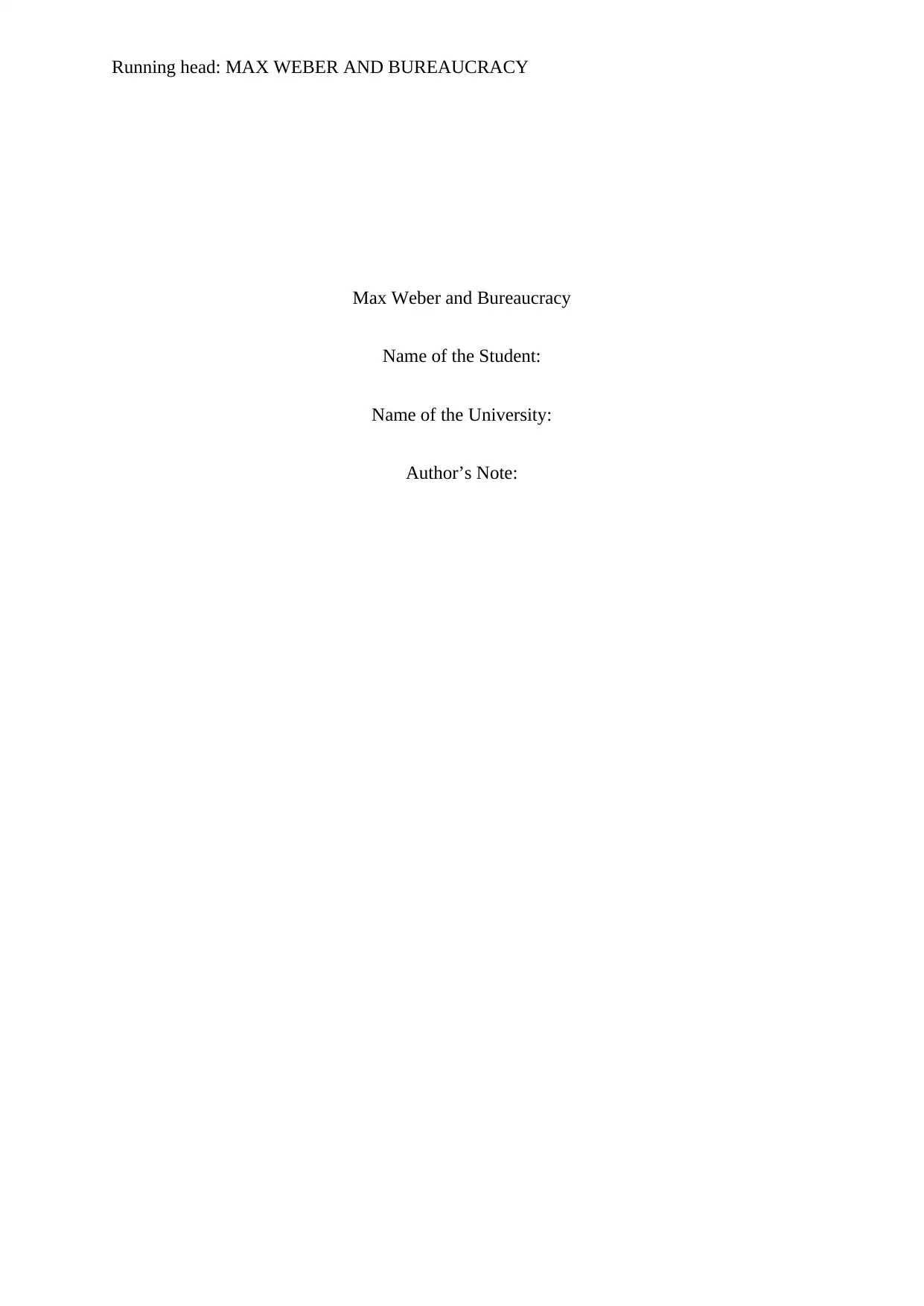
Running head: MAX WEBER AND BUREAUCRACY
Max Weber and Bureaucracy
Name of the Student:
Name of the University:
Author’s Note:
Max Weber and Bureaucracy
Name of the Student:
Name of the University:
Author’s Note:
Secure Best Marks with AI Grader
Need help grading? Try our AI Grader for instant feedback on your assignments.
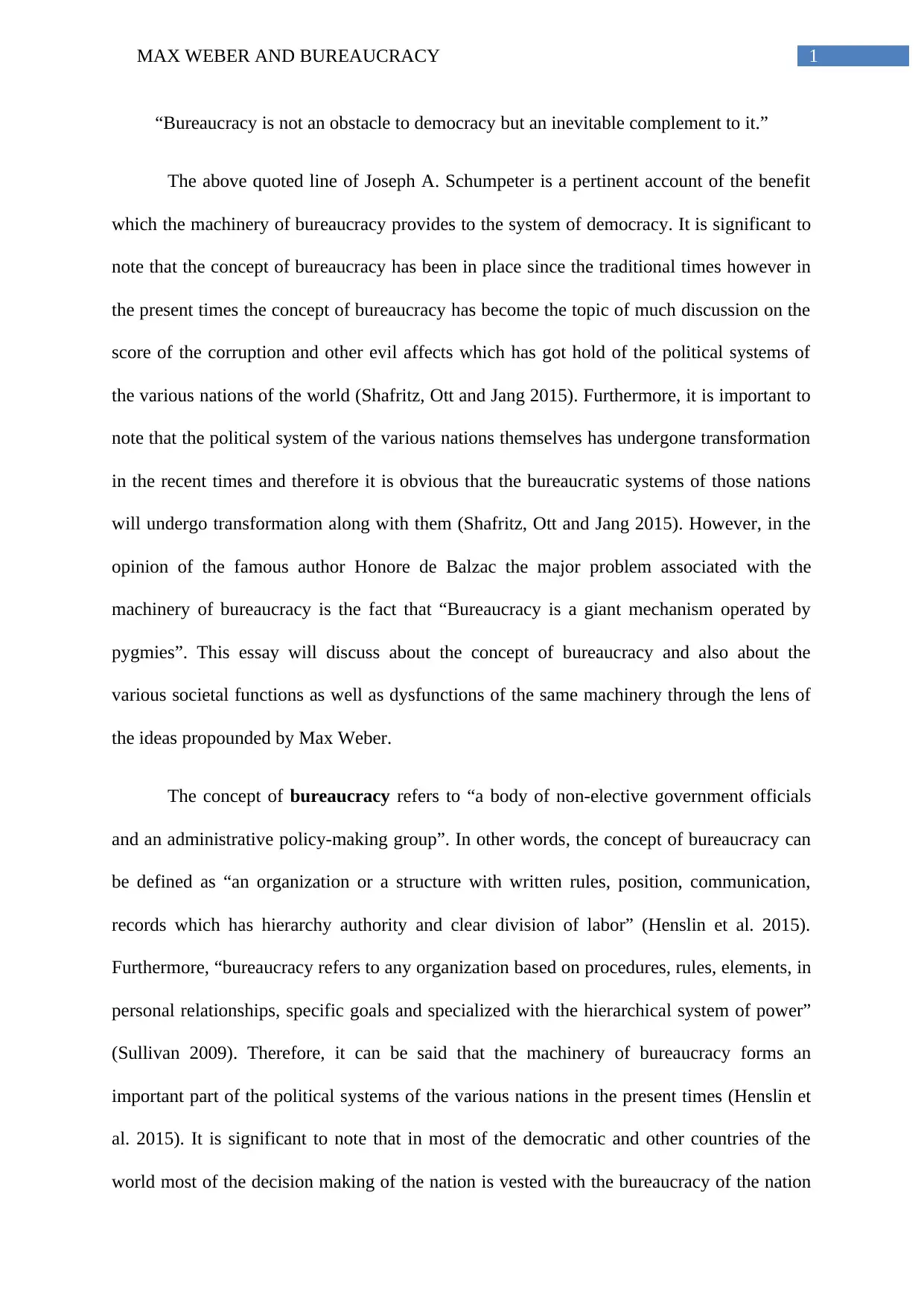
1MAX WEBER AND BUREAUCRACY
“Bureaucracy is not an obstacle to democracy but an inevitable complement to it.”
The above quoted line of Joseph A. Schumpeter is a pertinent account of the benefit
which the machinery of bureaucracy provides to the system of democracy. It is significant to
note that the concept of bureaucracy has been in place since the traditional times however in
the present times the concept of bureaucracy has become the topic of much discussion on the
score of the corruption and other evil affects which has got hold of the political systems of
the various nations of the world (Shafritz, Ott and Jang 2015). Furthermore, it is important to
note that the political system of the various nations themselves has undergone transformation
in the recent times and therefore it is obvious that the bureaucratic systems of those nations
will undergo transformation along with them (Shafritz, Ott and Jang 2015). However, in the
opinion of the famous author Honore de Balzac the major problem associated with the
machinery of bureaucracy is the fact that “Bureaucracy is a giant mechanism operated by
pygmies”. This essay will discuss about the concept of bureaucracy and also about the
various societal functions as well as dysfunctions of the same machinery through the lens of
the ideas propounded by Max Weber.
The concept of bureaucracy refers to “a body of non-elective government officials
and an administrative policy-making group”. In other words, the concept of bureaucracy can
be defined as “an organization or a structure with written rules, position, communication,
records which has hierarchy authority and clear division of labor” (Henslin et al. 2015).
Furthermore, “bureaucracy refers to any organization based on procedures, rules, elements, in
personal relationships, specific goals and specialized with the hierarchical system of power”
(Sullivan 2009). Therefore, it can be said that the machinery of bureaucracy forms an
important part of the political systems of the various nations in the present times (Henslin et
al. 2015). It is significant to note that in most of the democratic and other countries of the
world most of the decision making of the nation is vested with the bureaucracy of the nation
“Bureaucracy is not an obstacle to democracy but an inevitable complement to it.”
The above quoted line of Joseph A. Schumpeter is a pertinent account of the benefit
which the machinery of bureaucracy provides to the system of democracy. It is significant to
note that the concept of bureaucracy has been in place since the traditional times however in
the present times the concept of bureaucracy has become the topic of much discussion on the
score of the corruption and other evil affects which has got hold of the political systems of
the various nations of the world (Shafritz, Ott and Jang 2015). Furthermore, it is important to
note that the political system of the various nations themselves has undergone transformation
in the recent times and therefore it is obvious that the bureaucratic systems of those nations
will undergo transformation along with them (Shafritz, Ott and Jang 2015). However, in the
opinion of the famous author Honore de Balzac the major problem associated with the
machinery of bureaucracy is the fact that “Bureaucracy is a giant mechanism operated by
pygmies”. This essay will discuss about the concept of bureaucracy and also about the
various societal functions as well as dysfunctions of the same machinery through the lens of
the ideas propounded by Max Weber.
The concept of bureaucracy refers to “a body of non-elective government officials
and an administrative policy-making group”. In other words, the concept of bureaucracy can
be defined as “an organization or a structure with written rules, position, communication,
records which has hierarchy authority and clear division of labor” (Henslin et al. 2015).
Furthermore, “bureaucracy refers to any organization based on procedures, rules, elements, in
personal relationships, specific goals and specialized with the hierarchical system of power”
(Sullivan 2009). Therefore, it can be said that the machinery of bureaucracy forms an
important part of the political systems of the various nations in the present times (Henslin et
al. 2015). It is significant to note that in most of the democratic and other countries of the
world most of the decision making of the nation is vested with the bureaucracy of the nation
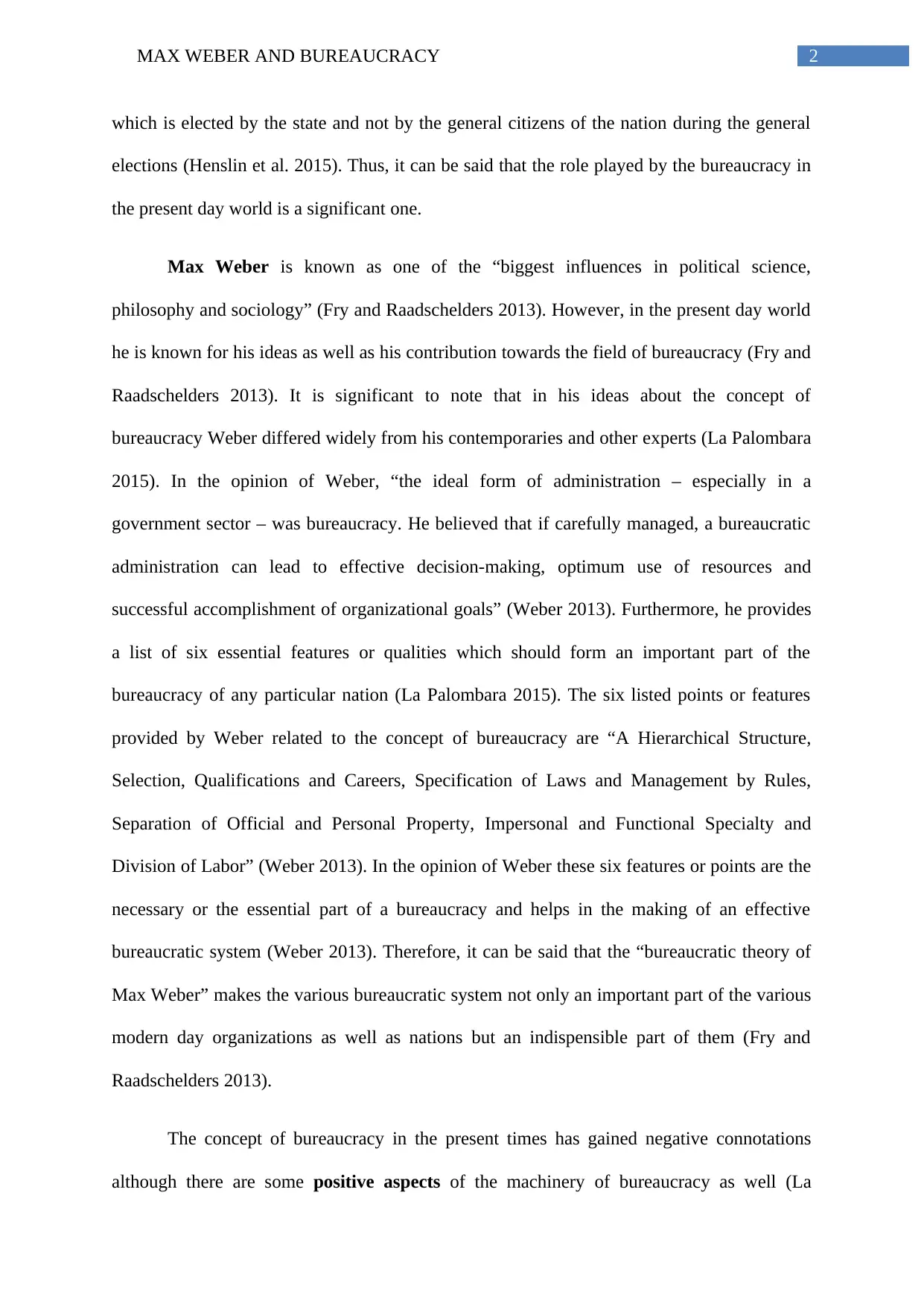
2MAX WEBER AND BUREAUCRACY
which is elected by the state and not by the general citizens of the nation during the general
elections (Henslin et al. 2015). Thus, it can be said that the role played by the bureaucracy in
the present day world is a significant one.
Max Weber is known as one of the “biggest influences in political science,
philosophy and sociology” (Fry and Raadschelders 2013). However, in the present day world
he is known for his ideas as well as his contribution towards the field of bureaucracy (Fry and
Raadschelders 2013). It is significant to note that in his ideas about the concept of
bureaucracy Weber differed widely from his contemporaries and other experts (La Palombara
2015). In the opinion of Weber, “the ideal form of administration – especially in a
government sector – was bureaucracy. He believed that if carefully managed, a bureaucratic
administration can lead to effective decision-making, optimum use of resources and
successful accomplishment of organizational goals” (Weber 2013). Furthermore, he provides
a list of six essential features or qualities which should form an important part of the
bureaucracy of any particular nation (La Palombara 2015). The six listed points or features
provided by Weber related to the concept of bureaucracy are “A Hierarchical Structure,
Selection, Qualifications and Careers, Specification of Laws and Management by Rules,
Separation of Official and Personal Property, Impersonal and Functional Specialty and
Division of Labor” (Weber 2013). In the opinion of Weber these six features or points are the
necessary or the essential part of a bureaucracy and helps in the making of an effective
bureaucratic system (Weber 2013). Therefore, it can be said that the “bureaucratic theory of
Max Weber” makes the various bureaucratic system not only an important part of the various
modern day organizations as well as nations but an indispensible part of them (Fry and
Raadschelders 2013).
The concept of bureaucracy in the present times has gained negative connotations
although there are some positive aspects of the machinery of bureaucracy as well (La
which is elected by the state and not by the general citizens of the nation during the general
elections (Henslin et al. 2015). Thus, it can be said that the role played by the bureaucracy in
the present day world is a significant one.
Max Weber is known as one of the “biggest influences in political science,
philosophy and sociology” (Fry and Raadschelders 2013). However, in the present day world
he is known for his ideas as well as his contribution towards the field of bureaucracy (Fry and
Raadschelders 2013). It is significant to note that in his ideas about the concept of
bureaucracy Weber differed widely from his contemporaries and other experts (La Palombara
2015). In the opinion of Weber, “the ideal form of administration – especially in a
government sector – was bureaucracy. He believed that if carefully managed, a bureaucratic
administration can lead to effective decision-making, optimum use of resources and
successful accomplishment of organizational goals” (Weber 2013). Furthermore, he provides
a list of six essential features or qualities which should form an important part of the
bureaucracy of any particular nation (La Palombara 2015). The six listed points or features
provided by Weber related to the concept of bureaucracy are “A Hierarchical Structure,
Selection, Qualifications and Careers, Specification of Laws and Management by Rules,
Separation of Official and Personal Property, Impersonal and Functional Specialty and
Division of Labor” (Weber 2013). In the opinion of Weber these six features or points are the
necessary or the essential part of a bureaucracy and helps in the making of an effective
bureaucratic system (Weber 2013). Therefore, it can be said that the “bureaucratic theory of
Max Weber” makes the various bureaucratic system not only an important part of the various
modern day organizations as well as nations but an indispensible part of them (Fry and
Raadschelders 2013).
The concept of bureaucracy in the present times has gained negative connotations
although there are some positive aspects of the machinery of bureaucracy as well (La
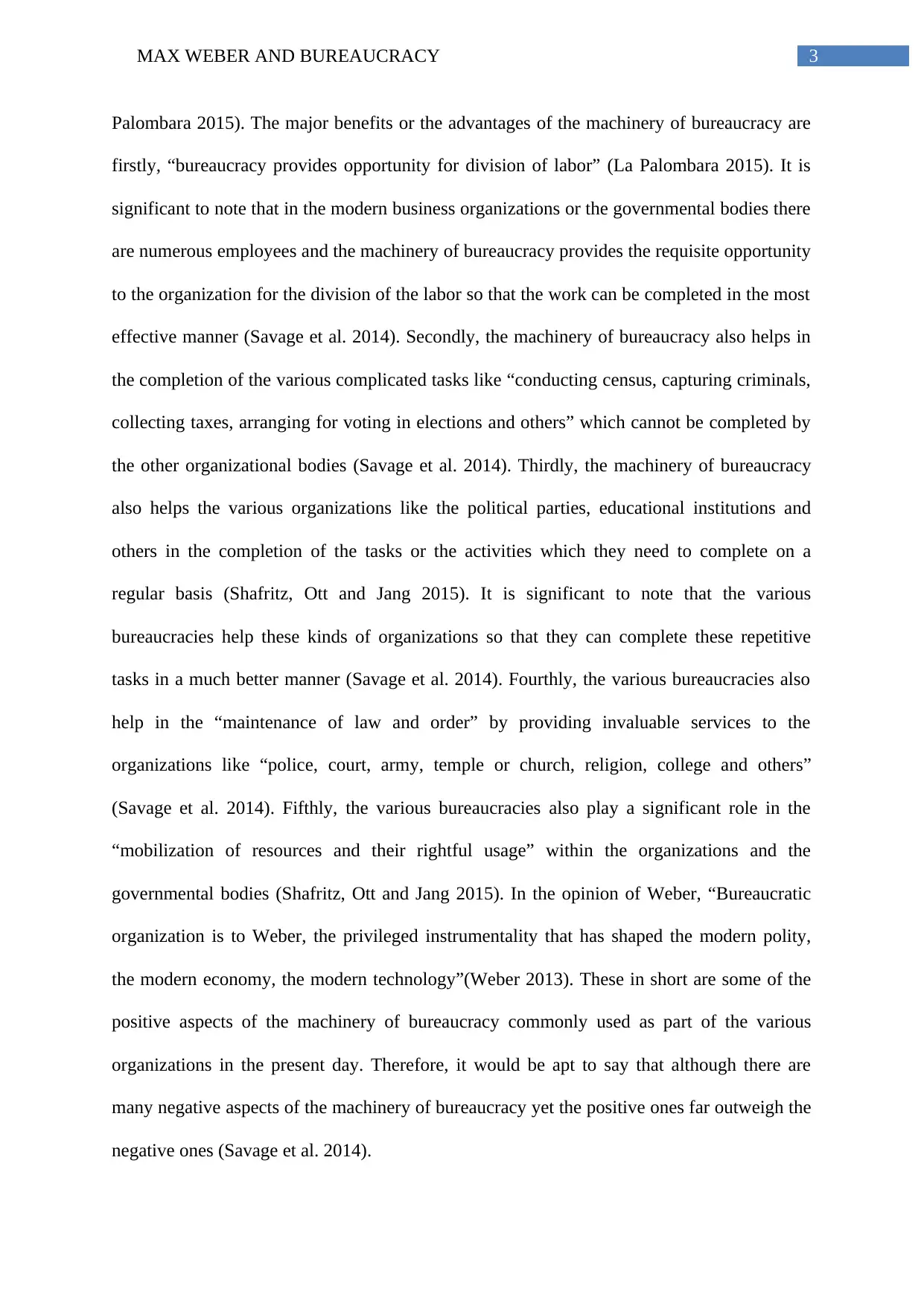
3MAX WEBER AND BUREAUCRACY
Palombara 2015). The major benefits or the advantages of the machinery of bureaucracy are
firstly, “bureaucracy provides opportunity for division of labor” (La Palombara 2015). It is
significant to note that in the modern business organizations or the governmental bodies there
are numerous employees and the machinery of bureaucracy provides the requisite opportunity
to the organization for the division of the labor so that the work can be completed in the most
effective manner (Savage et al. 2014). Secondly, the machinery of bureaucracy also helps in
the completion of the various complicated tasks like “conducting census, capturing criminals,
collecting taxes, arranging for voting in elections and others” which cannot be completed by
the other organizational bodies (Savage et al. 2014). Thirdly, the machinery of bureaucracy
also helps the various organizations like the political parties, educational institutions and
others in the completion of the tasks or the activities which they need to complete on a
regular basis (Shafritz, Ott and Jang 2015). It is significant to note that the various
bureaucracies help these kinds of organizations so that they can complete these repetitive
tasks in a much better manner (Savage et al. 2014). Fourthly, the various bureaucracies also
help in the “maintenance of law and order” by providing invaluable services to the
organizations like “police, court, army, temple or church, religion, college and others”
(Savage et al. 2014). Fifthly, the various bureaucracies also play a significant role in the
“mobilization of resources and their rightful usage” within the organizations and the
governmental bodies (Shafritz, Ott and Jang 2015). In the opinion of Weber, “Bureaucratic
organization is to Weber, the privileged instrumentality that has shaped the modern polity,
the modern economy, the modern technology”(Weber 2013). These in short are some of the
positive aspects of the machinery of bureaucracy commonly used as part of the various
organizations in the present day. Therefore, it would be apt to say that although there are
many negative aspects of the machinery of bureaucracy yet the positive ones far outweigh the
negative ones (Savage et al. 2014).
Palombara 2015). The major benefits or the advantages of the machinery of bureaucracy are
firstly, “bureaucracy provides opportunity for division of labor” (La Palombara 2015). It is
significant to note that in the modern business organizations or the governmental bodies there
are numerous employees and the machinery of bureaucracy provides the requisite opportunity
to the organization for the division of the labor so that the work can be completed in the most
effective manner (Savage et al. 2014). Secondly, the machinery of bureaucracy also helps in
the completion of the various complicated tasks like “conducting census, capturing criminals,
collecting taxes, arranging for voting in elections and others” which cannot be completed by
the other organizational bodies (Savage et al. 2014). Thirdly, the machinery of bureaucracy
also helps the various organizations like the political parties, educational institutions and
others in the completion of the tasks or the activities which they need to complete on a
regular basis (Shafritz, Ott and Jang 2015). It is significant to note that the various
bureaucracies help these kinds of organizations so that they can complete these repetitive
tasks in a much better manner (Savage et al. 2014). Fourthly, the various bureaucracies also
help in the “maintenance of law and order” by providing invaluable services to the
organizations like “police, court, army, temple or church, religion, college and others”
(Savage et al. 2014). Fifthly, the various bureaucracies also play a significant role in the
“mobilization of resources and their rightful usage” within the organizations and the
governmental bodies (Shafritz, Ott and Jang 2015). In the opinion of Weber, “Bureaucratic
organization is to Weber, the privileged instrumentality that has shaped the modern polity,
the modern economy, the modern technology”(Weber 2013). These in short are some of the
positive aspects of the machinery of bureaucracy commonly used as part of the various
organizations in the present day. Therefore, it would be apt to say that although there are
many negative aspects of the machinery of bureaucracy yet the positive ones far outweigh the
negative ones (Savage et al. 2014).
Secure Best Marks with AI Grader
Need help grading? Try our AI Grader for instant feedback on your assignments.
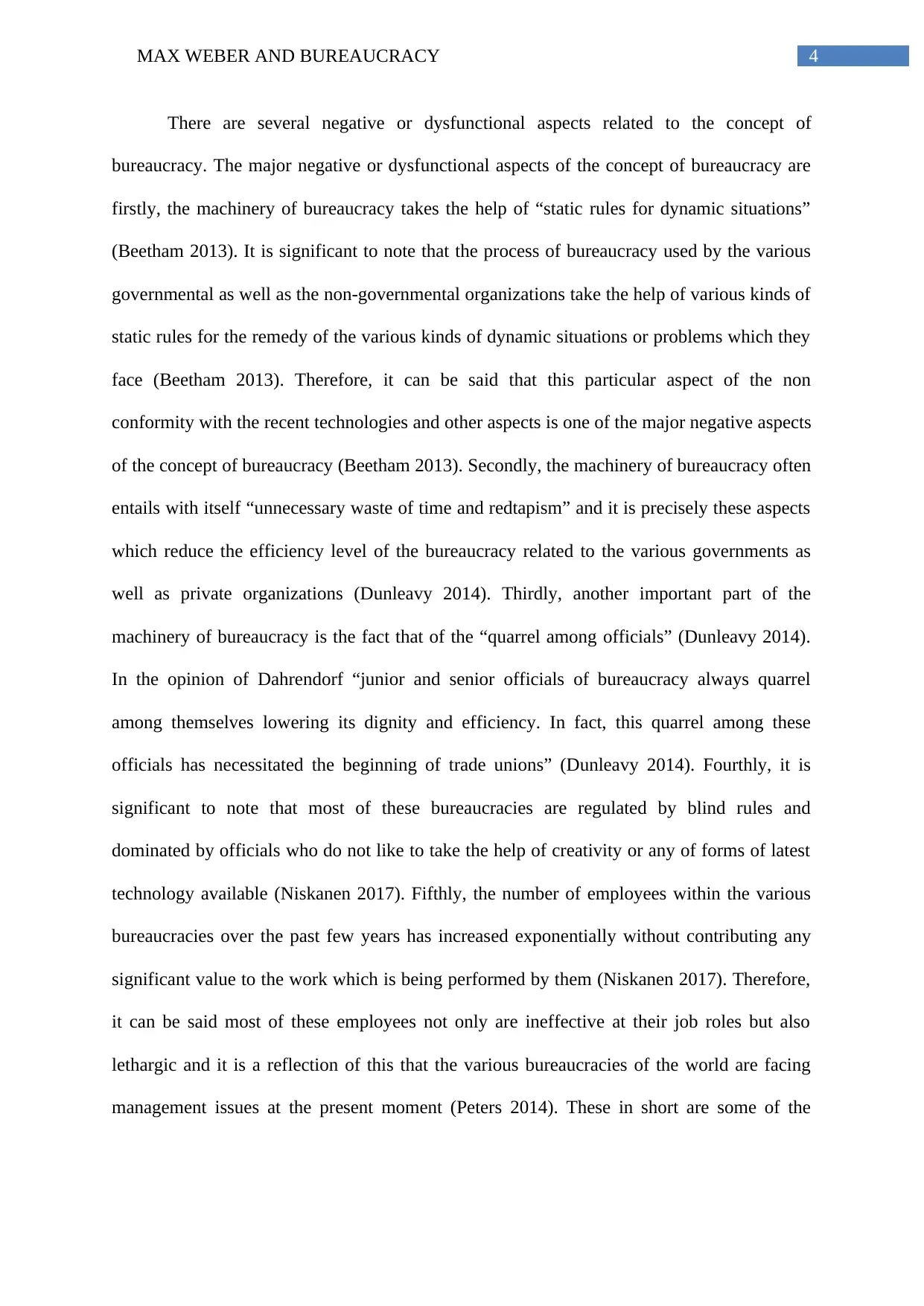
4MAX WEBER AND BUREAUCRACY
There are several negative or dysfunctional aspects related to the concept of
bureaucracy. The major negative or dysfunctional aspects of the concept of bureaucracy are
firstly, the machinery of bureaucracy takes the help of “static rules for dynamic situations”
(Beetham 2013). It is significant to note that the process of bureaucracy used by the various
governmental as well as the non-governmental organizations take the help of various kinds of
static rules for the remedy of the various kinds of dynamic situations or problems which they
face (Beetham 2013). Therefore, it can be said that this particular aspect of the non
conformity with the recent technologies and other aspects is one of the major negative aspects
of the concept of bureaucracy (Beetham 2013). Secondly, the machinery of bureaucracy often
entails with itself “unnecessary waste of time and redtapism” and it is precisely these aspects
which reduce the efficiency level of the bureaucracy related to the various governments as
well as private organizations (Dunleavy 2014). Thirdly, another important part of the
machinery of bureaucracy is the fact that of the “quarrel among officials” (Dunleavy 2014).
In the opinion of Dahrendorf “junior and senior officials of bureaucracy always quarrel
among themselves lowering its dignity and efficiency. In fact, this quarrel among these
officials has necessitated the beginning of trade unions” (Dunleavy 2014). Fourthly, it is
significant to note that most of these bureaucracies are regulated by blind rules and
dominated by officials who do not like to take the help of creativity or any of forms of latest
technology available (Niskanen 2017). Fifthly, the number of employees within the various
bureaucracies over the past few years has increased exponentially without contributing any
significant value to the work which is being performed by them (Niskanen 2017). Therefore,
it can be said most of these employees not only are ineffective at their job roles but also
lethargic and it is a reflection of this that the various bureaucracies of the world are facing
management issues at the present moment (Peters 2014). These in short are some of the
There are several negative or dysfunctional aspects related to the concept of
bureaucracy. The major negative or dysfunctional aspects of the concept of bureaucracy are
firstly, the machinery of bureaucracy takes the help of “static rules for dynamic situations”
(Beetham 2013). It is significant to note that the process of bureaucracy used by the various
governmental as well as the non-governmental organizations take the help of various kinds of
static rules for the remedy of the various kinds of dynamic situations or problems which they
face (Beetham 2013). Therefore, it can be said that this particular aspect of the non
conformity with the recent technologies and other aspects is one of the major negative aspects
of the concept of bureaucracy (Beetham 2013). Secondly, the machinery of bureaucracy often
entails with itself “unnecessary waste of time and redtapism” and it is precisely these aspects
which reduce the efficiency level of the bureaucracy related to the various governments as
well as private organizations (Dunleavy 2014). Thirdly, another important part of the
machinery of bureaucracy is the fact that of the “quarrel among officials” (Dunleavy 2014).
In the opinion of Dahrendorf “junior and senior officials of bureaucracy always quarrel
among themselves lowering its dignity and efficiency. In fact, this quarrel among these
officials has necessitated the beginning of trade unions” (Dunleavy 2014). Fourthly, it is
significant to note that most of these bureaucracies are regulated by blind rules and
dominated by officials who do not like to take the help of creativity or any of forms of latest
technology available (Niskanen 2017). Fifthly, the number of employees within the various
bureaucracies over the past few years has increased exponentially without contributing any
significant value to the work which is being performed by them (Niskanen 2017). Therefore,
it can be said most of these employees not only are ineffective at their job roles but also
lethargic and it is a reflection of this that the various bureaucracies of the world are facing
management issues at the present moment (Peters 2014). These in short are some of the
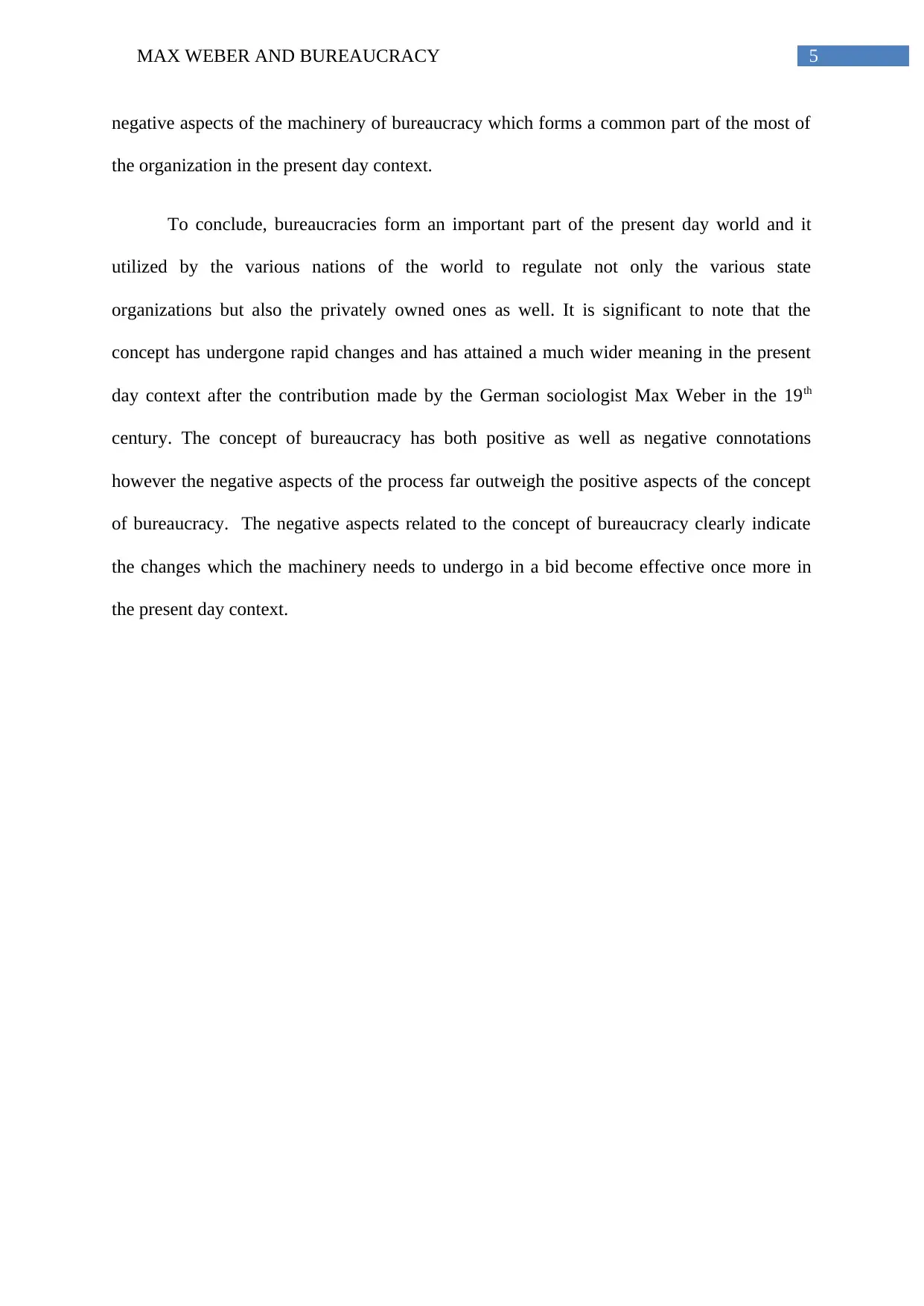
5MAX WEBER AND BUREAUCRACY
negative aspects of the machinery of bureaucracy which forms a common part of the most of
the organization in the present day context.
To conclude, bureaucracies form an important part of the present day world and it
utilized by the various nations of the world to regulate not only the various state
organizations but also the privately owned ones as well. It is significant to note that the
concept has undergone rapid changes and has attained a much wider meaning in the present
day context after the contribution made by the German sociologist Max Weber in the 19th
century. The concept of bureaucracy has both positive as well as negative connotations
however the negative aspects of the process far outweigh the positive aspects of the concept
of bureaucracy. The negative aspects related to the concept of bureaucracy clearly indicate
the changes which the machinery needs to undergo in a bid become effective once more in
the present day context.
negative aspects of the machinery of bureaucracy which forms a common part of the most of
the organization in the present day context.
To conclude, bureaucracies form an important part of the present day world and it
utilized by the various nations of the world to regulate not only the various state
organizations but also the privately owned ones as well. It is significant to note that the
concept has undergone rapid changes and has attained a much wider meaning in the present
day context after the contribution made by the German sociologist Max Weber in the 19th
century. The concept of bureaucracy has both positive as well as negative connotations
however the negative aspects of the process far outweigh the positive aspects of the concept
of bureaucracy. The negative aspects related to the concept of bureaucracy clearly indicate
the changes which the machinery needs to undergo in a bid become effective once more in
the present day context.
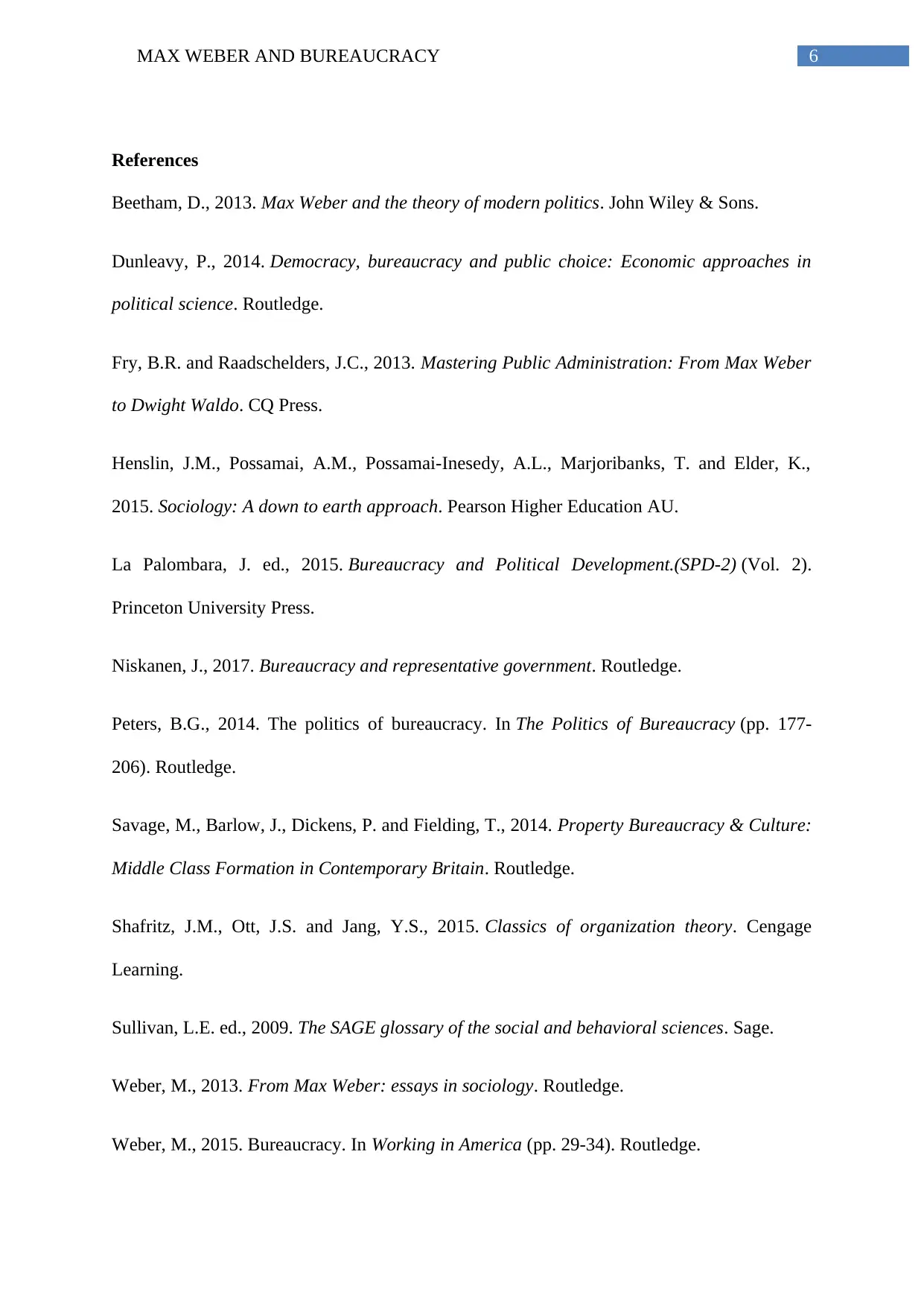
6MAX WEBER AND BUREAUCRACY
References
Beetham, D., 2013. Max Weber and the theory of modern politics. John Wiley & Sons.
Dunleavy, P., 2014. Democracy, bureaucracy and public choice: Economic approaches in
political science. Routledge.
Fry, B.R. and Raadschelders, J.C., 2013. Mastering Public Administration: From Max Weber
to Dwight Waldo. CQ Press.
Henslin, J.M., Possamai, A.M., Possamai-Inesedy, A.L., Marjoribanks, T. and Elder, K.,
2015. Sociology: A down to earth approach. Pearson Higher Education AU.
La Palombara, J. ed., 2015. Bureaucracy and Political Development.(SPD-2) (Vol. 2).
Princeton University Press.
Niskanen, J., 2017. Bureaucracy and representative government. Routledge.
Peters, B.G., 2014. The politics of bureaucracy. In The Politics of Bureaucracy (pp. 177-
206). Routledge.
Savage, M., Barlow, J., Dickens, P. and Fielding, T., 2014. Property Bureaucracy & Culture:
Middle Class Formation in Contemporary Britain. Routledge.
Shafritz, J.M., Ott, J.S. and Jang, Y.S., 2015. Classics of organization theory. Cengage
Learning.
Sullivan, L.E. ed., 2009. The SAGE glossary of the social and behavioral sciences. Sage.
Weber, M., 2013. From Max Weber: essays in sociology. Routledge.
Weber, M., 2015. Bureaucracy. In Working in America (pp. 29-34). Routledge.
References
Beetham, D., 2013. Max Weber and the theory of modern politics. John Wiley & Sons.
Dunleavy, P., 2014. Democracy, bureaucracy and public choice: Economic approaches in
political science. Routledge.
Fry, B.R. and Raadschelders, J.C., 2013. Mastering Public Administration: From Max Weber
to Dwight Waldo. CQ Press.
Henslin, J.M., Possamai, A.M., Possamai-Inesedy, A.L., Marjoribanks, T. and Elder, K.,
2015. Sociology: A down to earth approach. Pearson Higher Education AU.
La Palombara, J. ed., 2015. Bureaucracy and Political Development.(SPD-2) (Vol. 2).
Princeton University Press.
Niskanen, J., 2017. Bureaucracy and representative government. Routledge.
Peters, B.G., 2014. The politics of bureaucracy. In The Politics of Bureaucracy (pp. 177-
206). Routledge.
Savage, M., Barlow, J., Dickens, P. and Fielding, T., 2014. Property Bureaucracy & Culture:
Middle Class Formation in Contemporary Britain. Routledge.
Shafritz, J.M., Ott, J.S. and Jang, Y.S., 2015. Classics of organization theory. Cengage
Learning.
Sullivan, L.E. ed., 2009. The SAGE glossary of the social and behavioral sciences. Sage.
Weber, M., 2013. From Max Weber: essays in sociology. Routledge.
Weber, M., 2015. Bureaucracy. In Working in America (pp. 29-34). Routledge.
Paraphrase This Document
Need a fresh take? Get an instant paraphrase of this document with our AI Paraphraser
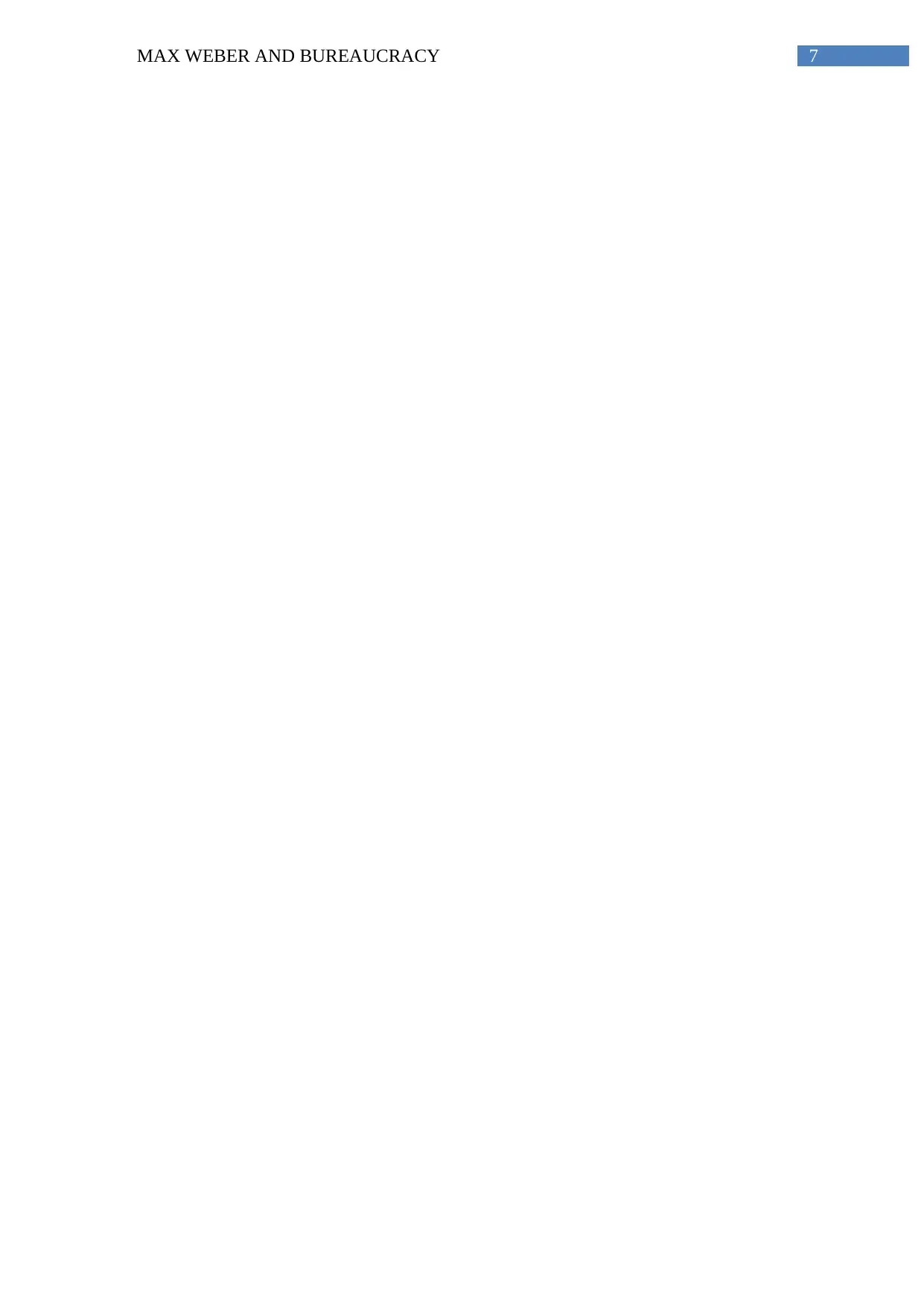
7MAX WEBER AND BUREAUCRACY
1 out of 8
Your All-in-One AI-Powered Toolkit for Academic Success.
+13062052269
info@desklib.com
Available 24*7 on WhatsApp / Email
![[object Object]](/_next/static/media/star-bottom.7253800d.svg)
Unlock your academic potential
© 2024 | Zucol Services PVT LTD | All rights reserved.



